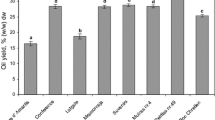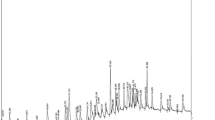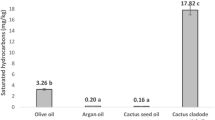Abstract
The phytosterol, tocopherol, and tocotrienol profiles for mkukubuyo, Sterculia africana, manketti, Ricinodendron rautanenni, mokolwane, Hyphaene petersiana, morama, Tylosema esculentum, and moretologa-kgomo, Ximenia caffra, seed oils from Botswana have been determined. Normal-phase HPLC analysis of the unsaponifiable matter showed that among the selected oils, the most abundant tocopherol and tocotrienol were γ-tocopherol (2232.99 μg/g) and γ-tocotrienol (246.19 μg/g), detected in manketti and mkukubuyo, respectively. Mokolwane oil, however, contained the largest total tocotrienol (258.47 μg/g). Total tocol contents found in manketti, mokolwane, mkukubuyo, morama, and moretologa-kgomo oils were 2238.60, 262.40, 246.20, 199.10, and 128.0 μg/g, respectively. GC–MS determination of the relative percentage composition of phytosterols showed 4-desmethylsterols as the most abundant phytosterols in the oils, by occurring up to 90% in moretologa-kgomo, mkukubuyo, and manketti seed oils, with β-sitosterol being the most abundant. Mokolwane seed oil contained the largest percentage composition of 4,4-dimethylsterols (45.93%). Besides 4-desmethylsterols (75%), morama oil also contained significant amounts of 4,4-dimethylsterols and 4-monomethylsterols (15.72% total). GC–MS determination of the absolute amounts of 4-desmethylsterols, after SPE fractionation of the unsaponifiable matter, confirmed that β-sitosterol was the most abundant phytosterol in the test seed oils, with manketti seed oil being the richest source (1326.74 μg/g). The analysis showed total 4-desmethylsterols content as 1617.41, 1291.88, 861.47, 149.15, and 109.11 μg/g for manketti, mokolwane, mkukubuyo, morama, and moretologa-kgomo seed oils, respectively.


Similar content being viewed by others
References
Hunter JE (2001) Studies on effects of dietary fatty acids as related to their position on triglycerides. Lipids 36:655–668
Wu Z, Rodgers RP, Marshall AG (2004) Characterization of vegetable oils: detailed compositional fingerprints derived from electrospray ionization Fourier transform ion cyclotron resonance mass spectrometry. J Agric Food Chem 52:5322–5328
Damirchi SA, Savage GP, Dutta PC (2005) Sterol fractions in hazelnut and virgin olive oils and 4,4-dimethylsterols as possible markers for detection of adulteration of virgin olive oil. J Am Oil Chem Soc 82:717–725
Awad AB, Fink CS (2000) Phytosterols as anticancer dietary components: evidence and mechanism of action. J Nutr 130:2127–2130
Piironen V, Lindsay DG, Miettinen TA, Toivo J, Lampi AM (2000) Plant sterols: biosynthesis, biological function and their importance to human nutrition. J Sci Food Agric 80:939–966
Mitei YC, Ngila JC, Yeboah SO, Wessjohann L, Schmidt J (2008) NMR, GC–MS and High resolution MS profiling of fatty acids and triacylglycerols in some seed oils from Botswana. J Am Oil Chem Soc 85:1021–1032
Wilson PW, Kodicek E, Booth VH (1962) Separation of tocopherols by gas-liquid chromatography. Biochem J 84:524–531
Parcerisa J, Casals I, Boatella J, Codony R, Rafecas M (2000) Analysis of olive and hazelnut oil mixtures by high-performance liquid chromatography–atmospheric pressure chemical ionisation mass spectrometry of triacylglycerols and gas–liquid chromatography of non-saponifiable compounds (tocopherols and sterols). J Chromatogr A 881:149–158
Lechner M, Reiter B, Lorbeer E (1999) Determination of tocopherols and sterols in vegetable oils by solid-phase extraction and subsequent capillary gas chromatographic analysis. J Chromatogr A 857:231–239
Damirchi SA, Dutta PC (2006) Novel solid-phase extraction method to separate 4-desmethyl-, 4-monomethyl-, and 4,4′-dimethylsterols in vegetable oils. J Chromatogr A 1108:183–187
Li J, Ho C, Li H, Tao H, Tao L (2000) Separation of sterols and triterpene alcohols from unsaponifiable fractions of three plant seed oils. J Food Lipids 7(1):11–20
Panfili G, Alessandra F, Mario I (2003) Normal phase high-performance liquid chromatography method for the determination of tocopherols and tocotrienols in cereals. J Agric Food Chem 51:3940–3944
Bruni R, Medici A, Guerrini A, Scalia S, Poli F, Romagnoli C, Muzzoli M, Sacchetti G (2002) Tocopherol, fatty acids and sterol distributions in wild Ecuadorian Theobroma subincanum (Sterculiaceae) seeds. Food Chem 77:337–341
Eitenmiller R, Lee J (2004) Analysis of tocopherols and tocotrienols in foods. In: Eitenmiller R, Lee J (eds) Vitamin E—Food Chemistry, Composition and Analysis. Marcel Dekker, New York, pp 323–423
The Natural Food Hub. The mongogo/manketti nut. http://www.naturalhub.com/natural_food_guide_nuts_uncommon_Ricinodendron_rautanenii.htm. Accessed Nov 2008
Carotech Inc. Sources of tocotrienols. http://tocotrienol.org/sources.htm Accessed Oct 2008
Gunstone FD (2000) Composition and properties of edible oils. In: Hamm W, Hamilton RJ (eds) Edible oil processing. Sheffield Academic Press, England, pp 1–38
Eitenmiller R, Lee J (2004) Oxidation and the role of vitamin E as an antioxidant in foods. In: Eitenmiller R, Lee J (eds) Vitamin E—food chemistry, composition and analysis. Marcel Dekker, New York, pp 89–135
Rena RJ, White KD, Jahngen EG (1997) Validated method for quantitation and identification of 4,4-desmethylsterols and triterpene diols in plant oils by thin-layer chromatography-high resolution gas chromatography-mass spectrometry. J AOAC Int 80:1272–1280
Moreau RA, Whitaker BD, Hicks KB (2002) Phytosterols, phytostanols and their conjugates in foods: structural diversity, quantitative analysis, and health promoting uses. Prog Lipid Res 41:457–500
Rossel JB (1998) Purity criteria for vegetable oils. In: Hamilton RJ (ed) Lipid analysis in oils and fats. Blackie Academic and Professional, London, pp 265–289
Firestone David (ed) (2006) Physical and chemical characteristics of oils, fats and waxes. AOCS Press, Champaign IL, p 118
Firestone David (ed) (2006) Physical and chemical characteristics of oils, fats and waxes. AOCS Press, Champaign IL, p 108
PhytoTrade Africa. Mongongo/Manketti from PhytoTrade Africa. http:www.phytotradeafrica.com/products/mongongo.htm Accessed Oct 2008
Acknowledgment
We like to thank the European Commission for funding the Morama II Project. Yulita Mitei would like to thank the German Academic Exchange Service (DAAD) for sponsoring her PhD studies.
Author information
Authors and Affiliations
Corresponding author
About this article
Cite this article
Mitei, Y.C., Ngila, J.C., Yeboah, S.O. et al. Profiling of Phytosterols, Tocopherols and Tocotrienols in Selected Seed Oils from Botswana by GC–MS and HPLC. J Am Oil Chem Soc 86, 617–625 (2009). https://doi.org/10.1007/s11746-009-1384-5
Received:
Revised:
Accepted:
Published:
Issue Date:
DOI: https://doi.org/10.1007/s11746-009-1384-5




